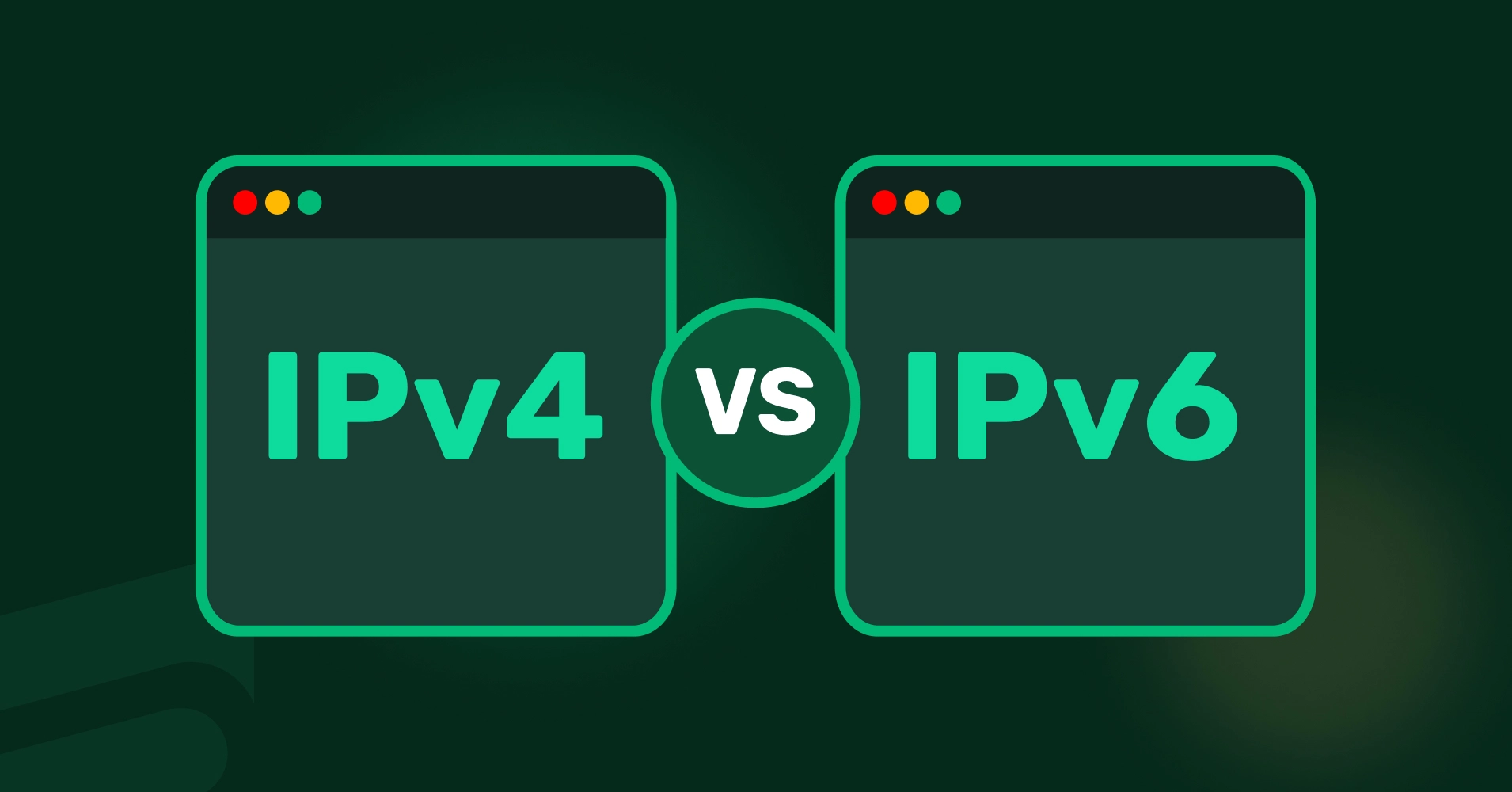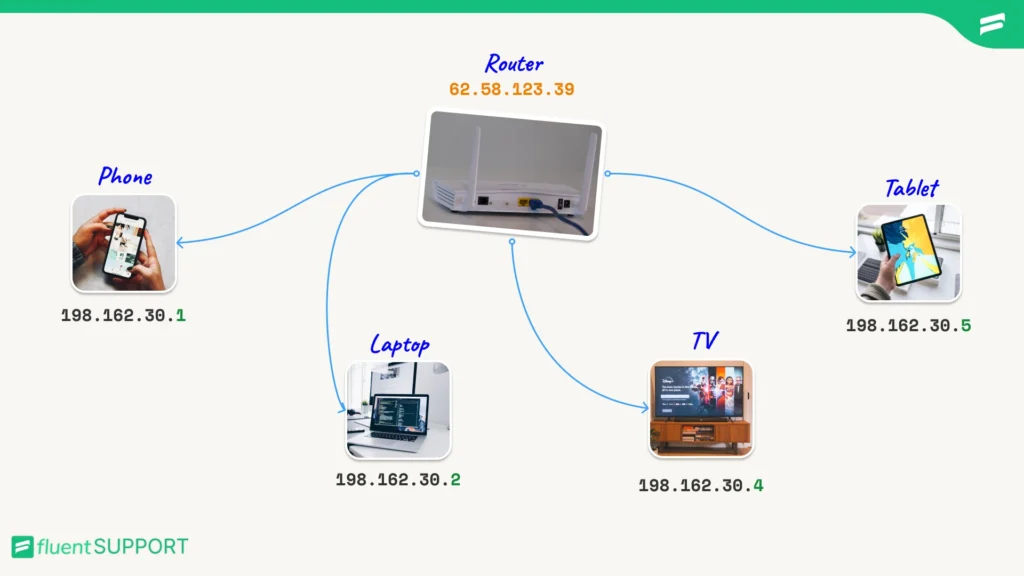
Whether you are a network or support engineer, a developer, or an internet user, would you prefer IPv4 over IPv6? To answer this question, you need to know about internet protocol.
When you send any data over the internet, it breaks down into small pieces. To send all the pieces to the right destination, they need an address. That’s where the internet protocol address, AKA IP address, comes in.
Before we get into IPv4 and IPv6, let’s start with the definition of IP.
What is IP, or internet protocol?
On the internet, there are sets of rules and ways of doing certain actions. This ensures multiple devices, domains, or servers can talk with each other easily. These rules are called internet protocol, or IP.
IP address
An IP address is literally the address of the device, domain, or server. This address is integrated with the data you sent through the internet so that it reaches the right destination. Usually it’s a string of numbers or a combination of letters and numbers.
Usually, every IP address has two parts. The first part is the network address, and the second part is the hosting. Here is the breakdown of an IP address.

Now, this is an IPv4 IP address. There are two versions of IP addresses available. The first one is IPv4, and the second one is IPv6. Let’s start with IPv4 first.
What is IPv4?
IPv4, or internet protocol version 4, is a 32-bit numerical address that has four sets of numbers separated by dots.
IPv4 was first described back in 1981 by the Internet Engineering Task Force (the Department of Defense of the USA). Later, it was put into use by the SATNET in 1982 and the ARPANET in 1983.
IPv4- 104.21.18.241
Now, here is something you might ask, it’s not a 32 digit number. Then why does it say 32-bit? Well, this IPv4 is made up of four binary octets, numerically ranging from 0 to 255. Which was later converted into a 32-bit binary number. Because computers can only read binary.
Here, each of the 32 bits can either be 0 or 1. So, if we do the math here, this will create more than 4.3 billion combinations.

Now the world population is around 8 billion, and 65% use the internet. That means 5.3 billion people are using the internet on multiple devices. Shouldn’t we have already run out of IPv4 addresses?
That’s not the case here, and we will get into it a bit later. Let’s get to know IPv6 now.
What is IPv6?
IPv6, or internet protocol version 6, is a 128-bit hexadecimal address that has eight sets of hexadecimal digits separated by colons.
The Internet Engineering Task Force made a draft of IPv6 in December 1998. Through Request for Comments 8200, the IETF announced in July 2017 that IPv6 has been standardized.
IPv6: 2606:4700:3036::6815:12f1
After converting this hexadecimal string to a binary, it will be 128-bit. That means you can create over 340 undecillion (37 more digits after 340) combinations in this version of the IP address.

This number is so big that no other version of the IP address is required very soon. At this point, we get to know about both of the IP versions. Now let’s compare both.
Difference between IPv4 VS IPv6
There are a few more distinctions between IPv4 and IPv6, in addition to the obvious length change.
| IPv4 | IPv6 | |
|---|---|---|
| Address size | 32 bits | 128 bits |
| Naming standard | Numerical digits | Hexadecimal digits |
| Address Configuration | Requires manual and DHCP configuration | Support auto configuration for stateless devices and DHCPv6 stateful devices. |
| Requires address translation | Through Network Address Translation (NAT) | Not required |
| Address Encryption | No encryption or authentication is initiated | Provides end-to-end data encryption. |
| DNS resolution | A records | AAAA records |
| Privacy | Mask to hide the last eight bits | Use random temporary addresses |
| Transmission scheme | Broadcasting | Multicasting |
| Fragmentation | By routers | By the originator |
| Mobility support | Requires Mobile IP | Better suited for frequent address changes |
Advantages of IPv6 over IPv4
As we can see, there are a lot of advantages to IPv6 over IPv4. It has an undecillion combinations, better privacy, end-to-end data encryption, is better for mobile devices, no need for NAT, is auto-configured, multicast, and the list goes on.
In short, IPv6 is far better than its older version. So, why are we not fully committed to this yet?
To answer this question, we have to ask one more question. Are they really running out of IP addresses?
Why still prefer IPv4 over IPv6?
The first reason is that we are not really running out of IPv4 addresses, as it seems. Because there is a thing called a local IP address. These addresses are assigned by the routers to devices connected to it.
These local IP addresses do not count as IPv4 addresses. The IP address assigned to the router, which is a public IP address, is IPv4. Not to mention, ISPs sometimes provide shared IP to multiple users.

That is to say, we are running out of IP addresses, but not as fast as it seems. However, the argument remains that IPv6 is still better and is now supported by a wide range of devices. So why are we holding back?
And the answer is compatibility issues. If two devices use a different version of the IP address, they cannot talk to each other. And when it comes to servers, it can show 502 gateway errors and even show “Network unreachable.”
But previously, I did say all the devices support IPv6 because it’s been standardized. So, compatibility shouldn’t be an issue, right? Well, it’s not us; it’s them, the ISPs and servers.
For ISPs, changing all the equipment to pure IPv6 equipment or dual standard equipment is very expensive. Not to mention, IPv4 has better support because of its widespread use and popularity. And the same goes for servers.
Another thing ISPs love is the control and visibility of their users. Because IPv4 lacks end-to-end encryption and because of its NAT, the ISP has better control.
Final thoughts
In conclusion, all we can say is that IPv6 is better. And you can purely use the IPv6 by disabling the IPv4 from your router. But for now, that might not be a good idea because only 23.5% of websites have adopted IPv6.
So, even though version 6 is better, we have to prefer IPv4 over IPv6. But the good news is that customer perception is changing. Day by day, ISPs and hosting servers are adopting IPv6 for communication addresses. In the near future, we might transfer to version 6, and version 4 will be a history of IP addresses.












Leave a Reply